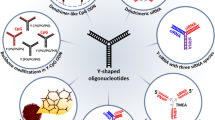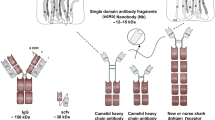Abstract
Purpose
We previously demonstrated that the immunostimulatory activity of CpG DNA is increased by the formation of polypod-like structures. The present study was designed to elucidate the mechanism underlying this increase.
Methods
Tripodna (three pods) and hexapodna (six pods) were prepared. The cellular uptake of Alexa Fluor 488-labeled DNA samples was examined in several cell lines by measuring the MFI of cells. TNF-α release from RAW264.7 cells was measured after addition of polypodna containing CpG motifs. Dissociation of double stranded DNA was evaluated using FRET.
Results
Tripodna and hexapodna were efficiently taken up by macrophage-like RAW264.7 cells and dendritic DC2.4 cells, but not by fibroblast or endothelial cell lines. The uptake by RAW264.7 cells was highest for hexapodna, followed by tripodna, dsDNA, and ssDNA. The release of TNF-α from RAW264.7 cells was also highest for hexapodna. The ratio of TNF-α release to cellular uptake was highest for ssDNA, and lowest for dsDNA. Tripodna and hexapodna were more easily dissociated into single strands after cellular uptake than was dsDNA.
Conclusions
The efficient cellular uptake and prompt dissociation into single strands can be directly related to the high immunostimulatory activity of polypod-like structured DNAs containing CpG motifs.





Similar content being viewed by others
Abbreviations
- ANOVA:
-
One-way analysis of variance
- BHQ:
-
Black hole quencher
- CpG DNA:
-
DNA containing unmethylated cytosine-phosphate-guanine dinucleotides
- DAPI:
-
4′,6-diamino-2-phenylindole
- DS:
-
Dextran sulfate
- EtBr:
-
Ethidium bromide
- FRET:
-
Fluorescence resonance energy transfer
- MFI:
-
Mean fluorescence intensity
- ODN:
-
Oligodeoxynucleotide
- PAGE:
-
Polyacrylamide gel electrophoresis
- PBMC:
-
Human peripheral blood mononuclear cells
- Polypodna:
-
Polypod-like structured DNA
- SR-A:
-
Type A scavenger receptor
- TLR9:
-
Toll-like receptor 9
- Tm:
-
Melting temperature
- TNF:
-
Tumor necrosis factor.
References
Nishikawa M, Rattanakiat S, Takakura Y. DNA-based nano-sized systems for pharmaceutical and biomedical applications. Adv Drug Deliv Rev. 2010;62:626–32.
Mohri K, Nishikawa M, Takahashi Y, Takakura Y. DNA nanotechnology-based development of delivery systems for bioactive compounds. Eur J Pharm Sci. 2014;58:26–33.
Charoenphol P, Bermudez H. Aptamer-targeted DNA nanostructures for therapeutic delivery. Mol Pharm. 2014;11:1721–5.
Matsuoka N, Nishikawa M, Mohri K, Rattanakiat S, Takakura Y. Structural and immunostimulatory properties of Y-shaped DNA consisting of phosphodiester and phosphorothioate oligodeoxynucleotides. J Control Release. 2010;148:311–6.
Mohri K, Takahashi N, Nishikawa M, Kusuki E, Shiomi T, Takahashi Y, et al. Increased immunostimulatory activity of polypod-like structured DNA by ligation of the terminal loop structures. J Control Release. 2012;163:285–92.
Hanagata N. Structure-dependent immunostimulatory effect of CpG oligodeoxynucleotides and their delivery system. Int J Nanomedicine. 2012;7:2181–95.
Walsh AS, Yin H, Erben CM, Wood MJ, Turberfield AJ. DNA cage delivery to mammalian cells. ACS Nano. 2011;5:5427–32.
Mohri K, Okuda T, Mori A, Danjo K, Okamoto H. Optimized pulmonary gene transfection in mice by spray-freeze dried powder inhalation. J Control Release. 2010;144:221–6.
Mohri K, Morimoto N, Maruyama M, Nakamoto N, Hayashi E, Nagata K, et al. Potential of D-Octaarginine-Linked Polymers as an in Vitro Transfection Tool for Biomolecules. Bioconjug Chem. 2015;26:1782–90.
Krieg AM. CpG Motifs in Bacterial DNA and Their Immune Effects. Annu Rev Immunol. 2002;20:709–60.
Hemmi H, Takeuchi O, Kawai T, Kaisho T, Sato S, Sanjo H, et al. A Toll-like receptor recognizes bacterial DNA. Nature. 2000;408:740–5.
Klinman DM, Yi AK, Beaucage SL, Conover J, Krieg AM. CpG motifs present in bacteria DNA rapidly induce lymphocytes to secrete interleukin 6, interleukin 12, and interferon gamma. Proc Natl Acad Sci U S A. 1996;93:2879–83.
Sparwasser T, Miethke T, Lipford G, Erdmann A, Häcker H, Heeg K, et al. Macrophages sense pathogens via DNA motifs: induction of tumor necrosis factor-alpha-mediated shock. Eur J Immunol. 1997;27:1671–9.
Vollmer J, Krieg AM. Immunotherapeutic Applications of CpG Oligodeoxynucleotide TLR9 Agonists. Adv Drug Deliv Rev. 2009;61:195–204.
Gupta GK, Agrawal DK. CpG Oligodeoxynucleotides as TLR9 Agonists: Therapeutic Application in Allergy and Asthma. BioDrugs. 2010;24:225–35.
Klinman DM. Immunotherapeutic Uses of CpG Oligodeoxynucleotides. Nat Rev Immunol. 2004;4:249–58.
Krieg AM. Therapeutic Potential of Toll-like Receptor 9 Activation. Nat Rev Drug Discov. 2006;5:471–84.
Monteith DK, Horner MJ, Gillett NA, Butler M, Geary R, Burckin T, et al. Evaluation of the renal effects of an antisense phosphorothioate oligodeoxynucleotide in monkeys. Toxicol Pathol. 1999;27:307–17.
Schmidt M, Anton K, Nordhaus C, Junghans C, Wittig B, Worm M. Cytokine and Ig-production by CG-containing sequences with phosphorodiester backbone and dumbbell-shape. Allergy. 2006;61:56–63.
Schüller VJ, Heidegger S, Sandholzer N, Nickels PC, Suhartha NA, Endres S, et al. Cellular immunostimulation by CpG-sequence-coated DNA origami structures. ACS Nano. 2011;5:9696–702.
Li J, Pei H, Zhu B, Liang L, Wei M, He Y, et al. Self-assembled multivalent DNA nanostructures for noninvasive intracellular delivery of immunostimulatory CpG oligonucleotides. ACS Nano. 2011;5:8783–9.
Koo JE, Shin SW, Um SH, Lee JY. X-shaped DNA potentiates therapeutic efficacy in colitis-associated colon cancer through dual activation of TLR9 and inflammasomes. Mol Cancer. 2015;14:104.
Mohri K, Nishikawa M, Takahashi N, Shiomi T, Matsuoka N, Ogawa K, et al. Design and development of nanosized DNA assemblies in polypod-like structures as efficient vehicles for immunostimulatory CpG motifs to immune cells. ACS Nano. 2012;6:5931–40.
Uno S, Nishikawa M, Mohri K, Umeki Y, Matsuzaki N, Takahashi Y, et al. Efficient delivery of immunostimulatory DNA to mouse and human immune cells through the construction of polypod-like structured DNA. Nanomedicine. 2014;10:765–74.
Platt N, Suzuki H, Kurihara Y, Kodama T, Gordon S. Role for the class A macrophage scavenger receptor in the phagocytosis of apoptotic thymocytes in vitro. Proc Natl Acad Sci U S A. 1996;93:12456–60.
Ohtsuki S, Matsuzaki N, Mohri K, Endo M, Emura T, Hidaka K, et al. Optimal Arrangement of Four Short DNA Strands for Delivery of Immunostimulatory Nucleic Acids to Immune Cells. Nucleic Acid Ther. 2015;25:245–53.
Rattanakiat S, Nishikawa M, Funabashi H, Luo D, Takakura Y. The assembly of a short linear natural cytosine-phosphate-guanine DNA into dendritic structures and its effect on immunostimulatory activity. Biomaterials. 2009;30:5701–6.
Mohri K, Kusuki E, Ohtsuki S, Takahashi N, Endo M, Hidaka K, et al. Self-assembling DNA dendrimer for effective delivery of immunostimulatory CpG DNA to immune cells. Biomacromolecules. 2015;16:1095–101.
Nishikawa M, Ogawa K, Umeki Y, Mohri K, Kawasaki Y, Watanabe H, et al. Injectable, self-gelling, biodegradable, and immunomodulatory DNA hydrogel for antigen delivery. J Control Release. 2014;180:25–32.
Nishikawa M, Mizuno Y, Mohri K, Matsuoka N, Rattanakiat S, Takahashi Y, et al. Biodegradable CpG DNA hydrogels for sustained delivery of doxorubicin and immunostimulatory signals in tumor-bearing mice. Biomaterials. 2011;32:488–94.
Umeki Y, Mohri K, Kawasaki Y, Watanabe H, Takahashi R, Takahashi Y, et al. Induction of potent antitumor immunity by sustained release of cationic antigen from a DNA-based hydrogel with adjuvant activity. Adv Funct Mater. 2015;25:5758–67.
Peiser L, Mukhopadhyay S, Gordon S. Scavenger receptors in innate immunity. Curr Opin Immunol. 2002;14:26–33.
Yamasaki Y, Sumimoto K, Nishikawa M, Yamashita F, Yamaoka K, Hashida M, et al. Pharmacokinetic analysis of in vivo disposition of succinylated proteins targeted to liver nonparenchymal cells via scavenger receptors: importance of molecular size and negative charge density for in vivo recognition by receptors. J Pharmacol Exp Ther. 2002;301:467–77.
Liedl T, Simmel FC. Switching the conformation of a DNA molecule with a chemical oscillator. Nano Lett. 2005;5:1894–8.
Marras SA, Kramer FR, Tyagi S. Efficiencies of fluorescence resonance energy transfer and contact-mediated quenching in oligonucleotide probes. Nucleic Acids Res. 2002;30:e122.
Xuan F, Hsing IM. Triggering hairpin-free chain-branching growth of fluorescent DNA dendrimers for nonlinear hybridization chain reaction. J Am Chem Soc. 2014;136:9810–3.
Chen Y, Lee SH, Mao C. A DNA nanomachine based on a duplex-triplex transition. Angew Chem Int Ed Engl. 2004;43:5335–8.
Li XM, Song J, Cheng T, Fu PY. A duplex-triplex nucleic acid nanomachine that probes pH changes inside living cells during apoptosis. Anal Bioanal Chem. 2013;405:5993–9.
Latz E, Verma A, Visintin A, Gong M, Sirois CM, Klein DC, et al. Ligand-induced conformational changes allosterically activate Toll-like receptor 9. Nat Immunol. 2007;8:772–9.
Zelenay S, Elías F, Fló J. Immunostimulatory effects of plasmid DNA and synthetic oligodeoxynucleotides. Eur J Immunol. 2003;33:1382–92.
Rutz M, Metzger J, Gellert T, Luppa P, Lipford GB, Wagner H, et al. Toll-like receptor 9 binds single-stranded CpG-DNA in a sequence- and pH-dependent manner. Eur J Immunol. 2004;34:2541–50.
Sanada Y, Shiomi T, Okobira T, Tan M, Nishikawa M, Akiba I, et al. Polypod-Shaped DNAs: Small-Angle X-ray Scattering and Immunostimulatory Activity. Langmuir. 2016;32:3760–5.
Author information
Authors and Affiliations
Corresponding author
Electronic Supplementary Material
Table S1
(PDF 66 kb)
Rights and permissions
About this article
Cite this article
Mohri, K., Nagata, K., Ohtsuki, S. et al. Elucidation of the Mechanism of Increased Activity of Immunostimulatory DNA by the Formation of Polypod-like Structure. Pharm Res 34, 2362–2370 (2017). https://doi.org/10.1007/s11095-017-2243-y
Received:
Accepted:
Published:
Issue Date:
DOI: https://doi.org/10.1007/s11095-017-2243-y




